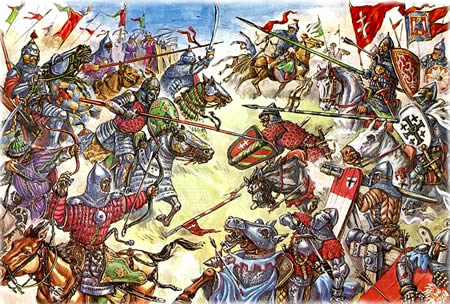 |
| Battle of the Horns of Hattin |
The Battle of the Horns of Hattin occurred on July 4, 1187, and resulted in the almost complete annihilation of the forces of the crusader army of Guy de Lusignan, king of Jerusalem (r. 1186–92), by the Muslim forces led by Saladin (Salah ad din, Yusuf).
The destruction of Guy’s army opened the way for the reconquest of not only Jerusalem, but also the other cities that had been captured during the First Crusade (1096–99), including Tiberias and Acre. The response to these defeats in the west led to the calling for and undertaking of the Third Crusade (1189–92).
The position of the crusader states had become precarious. The defeat of the Byzantine army at Myriocephalon in 1176 resulted in the end of effective Byzantine-crusader cooperation and, in subsequent years, Saladin managed to isolate the states further by retaking surrounding towns. Possession of towns and cities was crucial as they had supplies of fresh water and food that were almost completely absent from the arid, desert-like intervening territory.
  |
Crusader armies, which traveled wearing heavy armor and supporting large warhorses, were very difficult to maintain in this territory and were always vulnerable to disruption of supplies. An additional destabilizing factor was the importance of a number of significant, often divisive factions within the crusader court.
These included the Templar and Hospitaler knights, which had individual aims and intentions, as well as different aristocratic families jostling for power. These divisions brought the crusader states into a state of considerable tension and it may have been to deflect the possibility of civil war that Reginald of Châtillon attacked a caravan in an act seemingly set on ending the truce that had been established with Saladin (Salah ad Din).
Declaring jihad, Saladin brought troops up from Egypt to threaten Tiberias. His intention was to lure the crusaders into the open, where their supplies would soon be depleted and his own lightly armored horse archers could harass the enemy from a distance, inflicting a constant trickle of injuries.
Initially Guy resisted the temptation to attack but probably as the result of internal struggles, decided to lead his troops on a night-long march toward Saladin’s forces. The night march was disastrous as the troops were without water and suffered greatly in the hot, dry atmosphere. Saladin’s forces set fire to the vegetation to intensify this suffering.
The so-called Horns of Hattin were the two rocky hills that were part of an extinct volcano, on which Guy camped his troops, who by then were, it is said, almost maddened with thirst. There followed a day of fighting between the approximately 20,000 men on either side.
   |
The bulk of the crusader forces were armored infantry, conditioned to fighting in dense formations against similarly equipped foes. They were unable to get to grips with the mobile enemy and eventually they broke, fled, and were cut down on the battlefield.
Only Guy and some of his aristocrat companions were spared by Saladin, who ultimately ransomed them in exchange for the port of Ascalon. The Battle of the Horns of Hattin revealed the military inferiority of crusader technology and organization in a hostile environment and established a pattern of warfare for the rest of crusader history.
 |
| crusader forces cut down on the battlefield |
